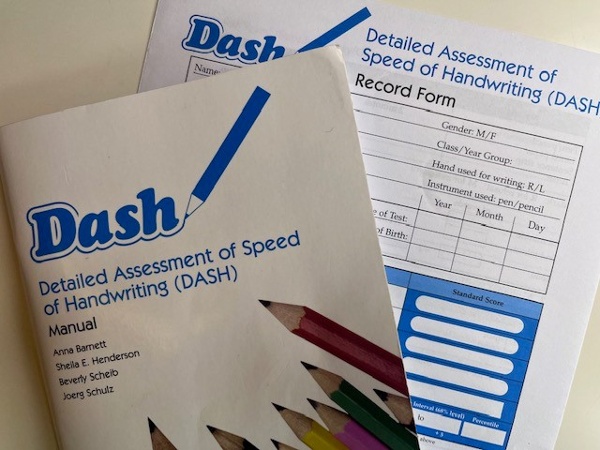DASH

Detailed Assessment of Speed of Handwriting (DASH)
The DASH was created to support in identifying children with handwriting difficulties, provide a reliable age-appropriate measure of handwriting speed, provide a detailed description of handwriting performance and evaluate intervention programmes.
The DASH is most suitable for children aged 9 and over and can support in identifying a pupil with slow writing before they fall behind and experience difficulties, especially prior to exams within secondary school.
Within the DASH there are a series of tasks that encompasses as many different aspects of the skill of handwriting speed as possible. Of the five component tasks of the test, four are writing tasks and one is a measurer of perceptual-motor competence.
First task, Copy Best – for the first task the individual will copy a sentence provided repeatedly in the best handwriting for 2 minutes with a “time mark” at 1 minute. This provides a baseline estimate of what the individual is capable of doing when trying their best.
Second task, Alphabet Writing – for the second task, the individual will write the alphabet in lower case continuously for one minute. This offers an insight into how fast the individual can generate the letters that should be known. This also allows the therapist to observe how well the individual knows the movement sequences required to form each letter accurately.
Third task, Copy Fast – for the third task, the individual will copy the same sentence as the first task repeatedly as quickly as possible for 2 minutes with a “time mark” at 1 minute. This judges the extent to which the individual can follow the ‘speed’ instruction and the accuracy of their formation in this task.
Fourth Task, Graphic Speed – this task requires the individual to make a series of crosses within circles, focusing on the fine motor/precision aspects of making a mark. This task represents a measure of perceptual-motor competence that is not related to language.
Fifth Task, Free Writing – the individual has 10 minutes to write about their life with a “time mark” every 2 minutes. They must generate a ‘story to tell’, work out the grammar for each sentence, the spelling of each word etc. This task allows the individual to generate material easily without too much thought or effort.
The scoring for each task is converted into a standard score and this is based off the age of the individual. The total score is then converted into an overall standard score and percentile ranking. The percentile ranking is then described as per the table below and advice can be provided from the therapist following this.
|
Child’s percentile range |
Description |
|
At or below 5th percentile |
Slow handwriting, requires intervention |
|
6th to 15th percentile |
Moderately slow handwriting, requires monitoring/further investigation |
|
At or above 16th percentile |
No difficulty |